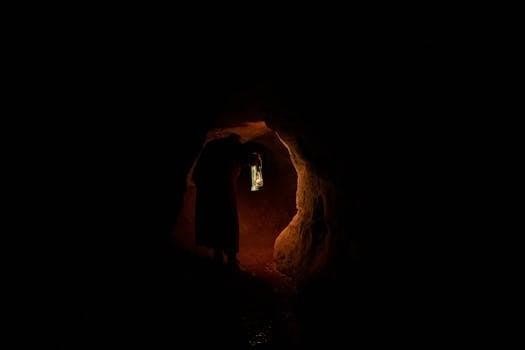Rosary Guide for Thursday⁚ Luminous Mysteries
Thursdays are dedicated to the Luminous Mysteries‚ also known as the Mysteries of Light․ These meditations focus on key moments in Jesus’ public ministry․ Join the communion of saints in prayer‚ reflecting on Christ’s life and teachings․
Welcome to the Thursday Rosary‚ a day dedicated to meditating on the Luminous Mysteries․ These mysteries illuminate key moments in Jesus’ public life‚ revealing His divine nature and the purpose of His mission․ As we embark on this prayerful journey‚ let us open our hearts and minds to the light of Christ‚ allowing it to guide our thoughts and deepen our understanding of His teachings․
The Luminous Mysteries offer a unique perspective on the life of Jesus‚ focusing on events that demonstrate His power‚ compassion‚ and the proclamation of the Kingdom of God․ Through these mysteries‚ we witness His baptism in the Jordan‚ the miracle at the wedding of Cana‚ His preaching of the Gospel‚ the Transfiguration on Mount Tabor‚ and the institution of the Eucharist․ Each mystery provides an opportunity to reflect on the significance of these events and their relevance to our own lives․
Join fellow believers around the world as we unite in prayer‚ forming one family in Christ․ As you pray each decade‚ ask God for help in areas of your life where a particular fruit is needed․ May the Holy Rosary bring your Rosary to life every Thursday․
The Luminous Mysteries⁚ An Overview
The Luminous Mysteries‚ a set of five meditations within the Rosary‚ focus on significant moments in the public ministry of Jesus Christ․ These mysteries‚ also known as the Mysteries of Light‚ were introduced by Pope John Paul II in 2002‚ aiming to bridge the gap between the Joyful and Sorrowful Mysteries‚ providing a fuller picture of Christ’s life․ They highlight events where Jesus revealed His divine glory and mission‚ illuminating His role as the Messiah and the Light of the World․
Each of the Luminous Mysteries offers a unique lens through which to contemplate Christ’s ministry․ The Baptism in the Jordan signifies the beginning of His public life and the descent of the Holy Spirit upon Him․ The Wedding at Cana reveals His power to perform miracles and His compassion for those in need․ The Proclamation of the Kingdom calls us to conversion and faith in the Gospel․ The Transfiguration foreshadows His resurrection and glory․ Finally‚ the Institution of the Eucharist establishes the sacrament of His Body and Blood‚ the source and summit of Christian life․
Through meditating on these mysteries‚ we can deepen our understanding of Christ’s life and teachings‚ and strengthen our relationship with Him․
First Luminous Mystery⁚ The Baptism of Jesus
The First Luminous Mystery centers on the Baptism of Jesus in the Jordan River by John the Baptist․ This event marks the beginning of Jesus’ public ministry and holds profound theological significance․ John‚ who was proclaiming a baptism of repentance‚ recognized Jesus as the Messiah‚ the One mightier than himself;
As Jesus entered the water‚ the heavens opened‚ and the Holy Spirit descended upon Him in the form of a dove․ A voice from heaven declared‚ “This is my beloved Son‚ with whom I am well pleased․” This divine affirmation confirms Jesus’ identity as the Son of God and inaugurates His mission to redeem humanity․
The Baptism of Jesus is not merely a symbolic act but a powerful moment of divine revelation․ It signifies Jesus’ solidarity with sinners‚ His acceptance of His Messianic role‚ and the beginning of His journey towards the cross․ Meditating on this mystery invites us to reflect on our own baptismal vows and to renew our commitment to follow Christ․
Consider the humility of Jesus‚ who‚ though sinless‚ submitted to baptism․ Ask for the grace to be open to the Holy Spirit and to live as beloved children of God․
Meditation on the Baptism in the Jordan

As you meditate on the Baptism in the Jordan‚ visualize the scene⁚ John the Baptist‚ preaching repentance‚ standing in the river․ See Jesus approaching‚ humbly joining the line of those seeking forgiveness․ Consider His purity‚ His willingness to identify with humanity’s sin․
Imagine the moment the heavens open‚ the Holy Spirit descending like a dove‚ and the Father’s voice proclaiming His love․ Feel the power of this divine affirmation‚ the confirmation of Jesus’ mission․
Reflect on the significance of water as a symbol of cleansing and new life․ Think about your own baptism‚ the moment you were washed clean and welcomed into God’s family․ Renew your commitment to the promises made on your behalf․
Ask yourself⁚ How can I better live out my baptismal calling? How can I be a witness to Christ’s love and forgiveness in the world? How can I open myself more fully to the guidance of the Holy Spirit?
Seek the spiritual fruit of humility‚ recognizing your own need for God’s grace․ Pray for the strength to follow Jesus’ example of obedience and service․ Embrace the identity of being a beloved child of God‚ empowered to live a life of purpose and meaning․
Second Luminous Mystery⁚ The Wedding at Cana

The Wedding at Cana‚ the second Luminous Mystery‚ unveils the beginning of Jesus’ public ministry and the powerful intercession of Mary․ Picture the joyful celebration‚ the sudden crisis when the wine runs out‚ threatening embarrassment for the hosts․
Witness Mary’s quiet observation‚ her compassionate understanding of the situation․ Hear her simple words to Jesus⁚ “They have no wine․” Reflect on her unwavering faith‚ her trust in her Son’s ability to help․
Observe Jesus’ initial hesitation‚ followed by his miraculous transformation of water into wine․ Consider the abundance of his provision‚ the superior quality of the wine he creates․ Recognize this as a sign of his divine power and his desire to bring joy․
Think about the role of the servants‚ their obedience to Jesus’ instructions․ See them filling the jars‚ trusting in his plan even when it seems illogical․ Their actions highlight the importance of obedience in our own lives․
Ask yourself⁚ Where am I lacking faith in Jesus’ ability to provide? How can I be more attentive to the needs of others‚ like Mary? How can I be more obedient to God’s will‚ even when it doesn’t make sense?
Seek the spiritual fruit of faith‚ asking for the grace to trust in God’s provision․ Pray for the intercession of Mary‚ the first among believers․ Embrace the joy of knowing that Jesus can transform our ordinary lives into something extraordinary․

The Significance of Mary’s Role at Cana
Mary’s role at the Wedding at Cana is pivotal‚ highlighting her unique position as intercessor and model of faith․ Her quiet observation of the situation demonstrates her attentiveness to the needs of others‚ a quality we should all strive to emulate․ Seeing the lack of wine‚ she doesn’t hesitate to approach Jesus‚ acting as a bridge between human need and divine power․
Her simple statement‚ “They have no wine‚” is a powerful act of intercession․ She doesn’t demand a miracle; she simply presents the problem to her Son‚ trusting in his compassion and ability to act․ This demonstrates her profound faith and her understanding of Jesus’ divine nature․
Jesus’ response‚ “Woman‚ what concern is that to you and to me? My hour has not yet come‚” initially seems dismissive․ However‚ Mary’s unwavering faith is evident in her instruction to the servants⁚ “Do whatever he tells you․” She trusts that Jesus will act‚ even if his timing is different from her own․
Mary’s instruction to the servants underscores the importance of obedience in our relationship with God․ We are called to listen to his voice and follow his guidance‚ even when we don’t fully understand his plan․
The miracle that follows is a direct result of Mary’s intercession and the servants’ obedience․ Jesus transforms water into wine‚ providing an abundance of joy for the wedding celebration․ This miracle reveals Jesus’ glory and strengthens the faith of his disciples․
Mary’s role at Cana teaches us the power of intercessory prayer‚ the importance of faith‚ and the call to obedience․ She is a model for all believers‚ showing us how to approach God with our needs and trust in his loving provision․
Third Luminous Mystery⁚ Proclamation of the Kingdom
The Third Luminous Mystery centers on Jesus’ active proclamation of the Kingdom of God․ This wasn’t merely a political announcement‚ but a profound spiritual message inviting a radical transformation of hearts and minds․ Jesus traveled throughout Galilee‚ teaching in synagogues and declaring the good news‚ emphasizing that the Kingdom was not a distant reality but was “at hand‚” present in his very person and ministry․
His proclamation was often accompanied by powerful signs and wonders‚ healing the sick‚ casting out demons‚ and performing miracles․ These acts served as tangible evidence of the Kingdom’s presence and power‚ demonstrating that God’s reign brought liberation and wholeness․ Jesus’ message challenged the existing social and religious structures‚ calling people to repentance and a new way of living․
The Kingdom Jesus proclaimed wasn’t about earthly power or dominion but about a reign of love‚ justice‚ and peace established in the hearts of believers․ He taught that entry into this Kingdom required a change of heart‚ a turning away from sin‚ and a commitment to following his teachings․ His parables‚ such as the Sower‚ the Mustard Seed‚ and the Lost Sheep‚ vividly illustrated the nature of the Kingdom and its demands․
Through his words and actions‚ Jesus revealed the character of God as a loving Father who desires the salvation of all․ He invited everyone‚ regardless of their social status or past‚ to enter the Kingdom and experience the fullness of life․ This mystery invites us to reflect on our own response to Jesus’ proclamation and to consider how we can actively participate in bringing the Kingdom of God to earth․
Understanding the Kingdom of God
The Kingdom of God‚ central to Jesus’ teachings‚ transcends a mere geographical location․ It’s a dynamic reality‚ a reign of divine love‚ justice‚ and peace established within human hearts and manifested through actions․ It is not limited by earthly boundaries but exists wherever God’s will is done․
Jesus proclaimed that the Kingdom was “at hand‚” meaning it was both present and future․ It was present in his own person‚ words‚ and actions‚ particularly in his miracles of healing and deliverance․ These acts demonstrated the power of God’s reign breaking into the world‚ offering liberation from sin‚ sickness‚ and oppression․ Yet‚ the Kingdom also has a future dimension‚ a promise of ultimate fulfillment when God’s will is perfectly realized on earth as it is in heaven․
Entering the Kingdom requires a transformation of heart and mind‚ a turning away from selfish desires and embracing God’s values․ This involves repentance‚ faith‚ and a commitment to living according to Jesus’ teachings․ The Beatitudes‚ for example‚ outline the characteristics of those who belong to the Kingdom⁚ the poor in spirit‚ the meek‚ those who hunger and thirst for righteousness‚ the merciful‚ the pure in heart‚ the peacemakers‚ and those who are persecuted for their faith․
Living in the Kingdom means actively participating in its growth and expansion․ This involves acts of love‚ service‚ and justice‚ working to alleviate suffering‚ promote reconciliation‚ and build a more just and compassionate world․ It also means proclaiming the good news of the Kingdom to others‚ inviting them to experience the transformative power of God’s reign in their lives․ Ultimately‚ understanding the Kingdom of God requires a continuous process of seeking‚ learning‚ and living out the values of Jesus Christ․
Fourth Luminous Mystery⁚ The Transfiguration
The Transfiguration‚ a pivotal event in the Gospels‚ reveals Jesus in his divine glory to Peter‚ James‚ and John․ On a high mountain‚ Jesus’ appearance was transformed‚ his face shining like the sun and his clothes becoming dazzling white․ This unveiling of Christ’s divinity offered a glimpse of his heavenly glory‚ foreshadowing his resurrection and ascension․
Alongside Jesus appeared Moses and Elijah‚ representing the Law and the Prophets‚ respectively․ Their presence signified that Jesus fulfilled the Old Testament prophecies and was the culmination of God’s plan of salvation․ A voice from heaven‚ God the Father himself‚ declared‚ “This is my beloved Son‚ with whom I am well pleased; listen to him․” This divine affirmation reinforced Jesus’ identity as the Son of God and emphasized the importance of heeding his teachings․
The Transfiguration served as a source of encouragement and hope for the disciples‚ who were soon to face the trials of Jesus’ Passion․ It strengthened their faith and prepared them for the difficult days ahead․ It also revealed the ultimate destiny of believers‚ who are called to share in Christ’s glory in the Kingdom of Heaven․
Meditating on the Transfiguration invites us to contemplate the glory of Christ and to recognize his divine presence in our lives․ It encourages us to listen to his voice and to follow him with unwavering faith‚ even in the midst of suffering․ It also reminds us of the ultimate hope of sharing in his eternal glory‚ a hope that sustains us on our earthly journey․
The Transfiguration as a Mystery of Light
The Transfiguration shines as a Mystery of Light‚ illuminating the divine nature of Jesus Christ․ This profound event on Mount Tabor offers a radiant glimpse into Jesus’ inherent glory‚ momentarily unveiled to his chosen apostles⁚ Peter‚ James‚ and John․ It’s a pivotal moment where heaven and earth converge‚ providing reassurance of Jesus’ true identity amidst his earthly ministry․
In this mystery‚ we witness Jesus transformed‚ his face radiating like the sun and his garments becoming brilliantly white․ This visual manifestation signifies his divine essence‚ transcending his human form․ The presence of Moses and Elijah‚ representing the Law and the Prophets‚ underscores Jesus’ fulfillment of ancient prophecies and his role as the Messiah․
The voice of God the Father echoes from the heavens‚ declaring‚ “This is my beloved Son‚ with whom I am well pleased; listen to him․” This divine affirmation reinforces Jesus’ authority and invites us to heed his teachings․ The Transfiguration‚ therefore‚ serves as a beacon‚ guiding us towards a deeper understanding of Christ’s divinity and our call to follow him․
Meditating on this mystery encourages us to seek the light of Christ in our own lives‚ allowing his glory to transform us from within․ It reminds us that even in moments of darkness or doubt‚ the radiant truth of Jesus’ divinity remains a source of hope and inspiration․
Fifth Luminous Mystery⁚ The Institution of the Eucharist
The Institution of the Eucharist‚ the Fifth Luminous Mystery‚ marks a pivotal moment in salvation history․ During the Last Supper‚ Jesus‚ knowing his hour had come‚ transformed ordinary bread and wine into his own Body and Blood․ This sacred act established the Eucharist as a perpetual memorial of his sacrifice‚ a sacrament of love‚ and a source of grace for all believers․
Jesus took bread‚ gave thanks‚ broke it‚ and gave it to his disciples‚ saying‚ “Take this‚ all of you‚ and eat of it‚ for this is my Body‚ which will be given up for you․” Similarly‚ he took the cup of wine‚ gave thanks‚ and said‚ “Take this‚ all of you‚ and drink from it‚ for this is the chalice of my Blood‚ the Blood of the new and eternal covenant‚ which will be poured out for you and for many for the forgiveness of sins․ Do this in memory of me․”
Through these words and actions‚ Jesus instituted the most sublime sacrament‚ a tangible expression of his boundless love and self-sacrifice․ The Eucharist is not merely a symbol; it is the real presence of Christ‚ body‚ blood‚ soul‚ and divinity․ By partaking in this sacred meal‚ we enter into communion with Christ and with one another‚ becoming one body in him․

Reflecting on this mystery deepens our appreciation for the gift of the Eucharist and strengthens our desire to receive it worthily and frequently․ It invites us to contemplate the profound mystery of God’s love made manifest in this sacrament and to allow it to transform our lives․
